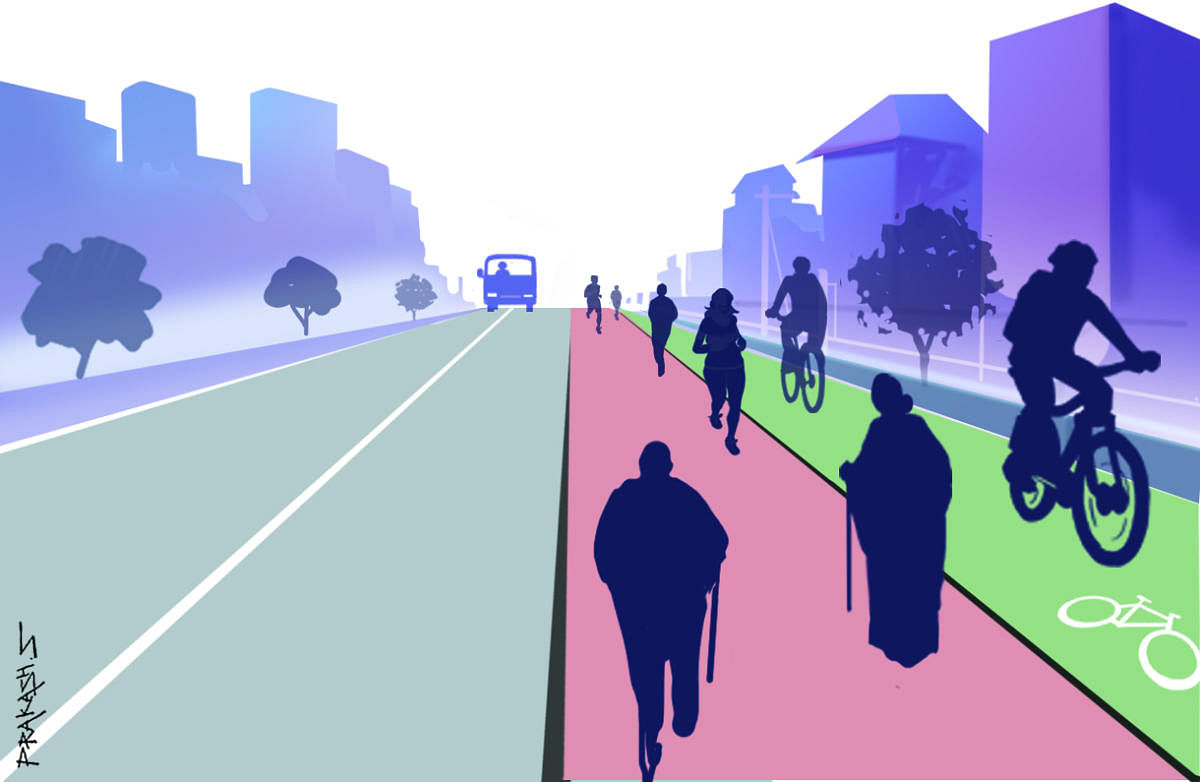Decongested, walkable and eminently accessible by bicycles, the city roads had presented a unique picture of serenity during the lockdown. But soon, the ‘unlocks’ unleashed the power of the motorised monsters, reclaiming every inch. Pedestrians, cyclists and e-vehicles were back on the edge.
The lockdown weeks had offered Bengalureans a glimpse of sustainable mobility and how open spaces can be reimagined. It suddenly seemed possible to reclaim the city’s green, beautiful past with the right policy interventions. The public spaces seemed just a brisk walk away, the last mile to the home just a pedal away.
But the euphoria was short-lived. The traffic is back, and with more private, personal vehicles than before. Despite the social-distancing norms in public transport buses and the Metro, the fear of contracting Covid-19 has forced many to switch to their own cars and two-wheelers. Edged out, the pedestrians find the footpaths as broken and unwalkable as before.
Momentum lost
The cyclists are clearly out of the main roads. Before Covid-19 applied the brakes, mobility startups had begun to make an impact using bicycles as a last-mile mobility option. But they lost the momentum due to the pandemic spread, as Jaya Dhindaw, Director, Integrated Urban Planning, at the World Research Institute (WRI) points out.
Looking beyond the main roads, do the local neighbourhoods offer hope? Shrinking open spaces and the few parks that remain shut most of the day have left residents with few places to go to, either by walk or by cycle. “There is a real need for more public spaces. The existing ones are already very crammed.”
Institution spaces
She suggests a way forward: “Public spaces could be explored inside institutions with large landholdings and big campuses, such as schools, colleges and the likes of the Indian Institute of Science. The existing local parks should be open for the public the entire day, closing only during the night. More people can be accommodated this way.”
More neighbourhood parks and open spaces, accessible by walk and cycling, are critical even from a mental health perspective, notes Jaya. Both the elderly and children will benefit from such spaces if a safe environment is guaranteed.
Below WHO standard
Despite being dubbed a garden city, Bengaluru has a green space area of merely 2 sqm per person. “This is very inadequate. The World Health Organisation (WHO) recommends an area of 9 sqm/person. There is a need to explore creative ways of increasing open green spaces such as institutional campuses and rooftops.”
Seamless access to the open spaces is a key requirement. “These spaces should be within a kilometer from the house, accessible by unbroken sidewalks that can be negotiated by even little children and those on wheelchairs. Today, everything is about imposing boundaries. This should change.”
Shops and car-fixation
Mobility options should turn sustainable even in the commercial hubs, contends the city’s bicycle mayor Sathya Sankaran from Citizens for Sustainability (CiFoS). In most areas with high business activity, shops and commercial establishments are still tied to the idea of customers coming in cars and parking them close-by.
The competition is against the malls where bulk-buying is the norm. “They (retailers) don’t seem to think that customers can buy small and come back. There is a resistance to walk. However, many bureaucrats are now coming around, exploring ways to boost walkability and pedestrian-friendly streets.”
SuMA initiative
Crowd-sourcing ideas, the Directorate of Urban Land Transport (DULT) had recently invited citizen groups to propose sustainable transport solutions in their neighbourhoods. The initiative, called Sustainable Mobility Accords (SuMA), has on offer Rs 50 lakh each to the 10 best ideas, as a fund to implement the approved projects and the required technical expertise.
The DULT objective is this: To develop ‘sustainable neighbourhoods’ where eventually, 80% of the residents’ trips would be by walking or cycling. Sixty per cent of the trips outside the neighbourhood would be by public transport.
Enthused by the mobility challenge, several citizen groups and residents welfare associations have sent their ideas. The deadline has now been extended till October 7.
